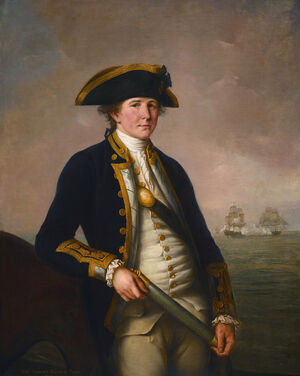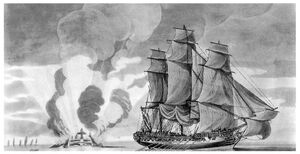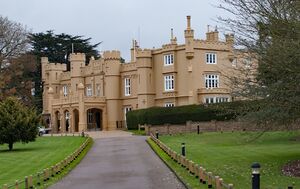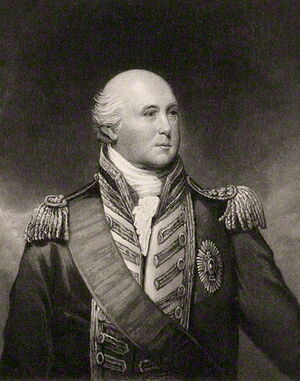Contents |
Biography
Family Life
Charles Morice Pole was born in Devon, England on 18 January 1757. He was the third child and second son of Reginald Pole and Anne (Buller) Pole.[1] Charles was baptised in Stoke Damerel, Devon, England on 21 February 1757.[2]
Charles married Henrietta Goddard in Woodford, St Mary the Virgin, Essex, England, on 8 June 1792.[3]
There were three children of the union, namely, Henrietta Maria Sarah (Pole) Stuart (1799 - 1853), Anna Maria Pole (1803-1871)[4] and Charlotte Jemima Pole (1805 - 1822)[5]. Henrietta married William Stewart (1798 - 1874), MP for Armagh, Northern Ireland, with whom she had six children.[6]
In 1811 Charles acquired a country house at Aldenham in Hertfordshire, England as his family seat and "Aldenham Abbey". It has since been renamed as "Wall Hall"[7] His town residence was at 18 Harley Street, London to which he moved in the 1820s.[8]
Sir Charles passed away at Denham Abbey, Aldenham, Hertsmere, Hertfordshire, England on 6 September 1830.[9]
A Death Notice appeared in "The Belfast Newsletter (Birth, Marriage and Death Notices), 1738-1925" on 14 September 1830.[10]
Sir Charles was buried at St John the Baptist, Aldenham, Hertfordshire, England on 14 September 1830.[11] In the absence of any record of a headstone, there is a record of memorial panels in the church dedicated to a number of members of the Pole family. These are described in a chapter entitled Aldenham Church, St John the Baptist, in Hertfordshire - Monuments in a publication called "Hertfordshire Church Monuments", thus:
- "Charlotte Jemima Pole, d.1822, Anna Maria Pole, d.1852, and their mother Dame Henrietta [Goddard] Pole, d.1842, wife of Admiral Sir Charles Morice Pole, Baronet, d.1830. Plain white panel on black backing, signed by Crake of London – he exerts himself rather more in the Denny monument noted below. Admiral Pole has a similarly plain panel, again by Crake, with a brief eulogy noting he was Master of the Robes to William IV, and Admiral of the Fleet.'"[12]
Will: Charles' Last Will and Testament is dated 24 May 1830 and proved on 24 November 1830 at the Prerogative Court of Canterbury. [13]
Naval Life
In January 1770, Charles entered the Royal Naval Academy - a facility established in 1733 in Portsmouth Dockyard to provide an alternative means of recruiting Royal Navy officers as well as standardised training, education and admission.[14]
On completion of his studies in 1772, Charles embarked for the East Indies as a Midshipman, on the frigate, "Thames"[14] and, after his return to England, appointed a Captain on 22 March 1779[14]

|
| Capt. Charles Morice Pole - 1781 |
Over the next four years he served with the Channel Fleet, successively and successfully commanding increasingly larger vessels from the 28-gun "Hussar" which he took to North America in 1791, to the 74-gun "Illustrious" in the Mediterranean.[14]
In 1782, however, while accompanying the store-ship Vernon on route to Gibraltar, Charles, as Captain of the "Success", encountered the Spanish "Santa Catalina", off the coast of Morocco. Determined at all costs to save the Vernon, he engaged an opponent said to have been the largest frigate afloat, and after two hours close action, captured her.[14] An action that later drew commendation from Captain Nelson.
At the beginning of the war with France in 1793, Charles' services were too valuable to be passed unnoticed; and he was, accordingly, appointed to the command of the "Colossus" in which he took part in the siege of Pondicherry and at the occupation of Toulon in 1793. He attained the rank of Rear-Admiral on 1 June 1795.[14] After serving for some time in the Channel Fleet, he sailed for the West Indies, with his flag in the "Colossus", where he served until his return to Europe in 1796 and subsequent appointment as First Captain in the Grand Fleet.[14] It was then back to the Mediterranean again, where on the "Royal George" he commanded a squadron detached against some Spanish ships int the Basque Roads.
On his return from that posting, the Board of Admiralty's approval of his conduct was marked by his appointment in 1800 as Commander-in-Chief and Governor of Newfoundland,[15] to which station he proceeded in the 64-gun "Agincourt".[14] His term there was, however, shortened by the illness and urgent desire of Lord Nelson to be recalled from the Baltic, and he was appointed to relieve his friend in that important command, during the summer of 1801. On the first day of that year, he had been advanced to the rank of Vice-Admiral.[14] To succeed such an officer as the heroic Nelson, even if in a relieving capacity, and at so critical a moment, was a tribute to his distinguished career to that point, and the confidence shown in him that he could complete the work which Nelson had started.[14] There is no way of knowing whether Admiral Nelson in any way influenced Charles' appointment, but there is no doubt that Nelson held him in high regard, as this extract from John Marshall's "Royal Naval Biography — Pole" illustrates:
- "Captain Pole’s friend, the gallant Nelson, on perusing the unassuming manner in which the Commander of the Success spoke of this action in his official letter, observed (when writing to their former patron, Captain Locker), 'I am exceedingly happy at Charles Pole’s success. In his seamanship he shewed himself as superior to the Don as in his gallantry, and no man in the world was ever so modest in his account of it.' And afterwards, in another letter to the same gentleman, Captain Nelson added, 'Never was there a young man who bore his own merits with so much modesty; I esteem him as a brother.'"[16]
Vice-Admiral Pole was next appointed to the command of the squadron off Cadiz where he remained watching that port until the suspension of hostilities at the end of 1801 enabled him to return to England[14]
In consequence of Nelson's decisive victory at Trafalgar on 21 October 1805, a general promotion took place and Charles became a full Admiral on the 9 November but saw no further action afloat.[14]
Parliamentary Life
Charles had expectations of being returned as the member for East Looe in 1796 but in the end his nomination was passed over. At the general election of 1802, however, he was chosen to represent the borough of Newark-upon-Trent, in Nottinghamshire. He was soon after appointed to the Commission to inquire into the abuses in Naval administration. And it was as its Chairman that he made his first known speech in the House on 4 May 1803. [17] That such a Commission was justified can be seen from this extract taken from the biography of the then First Lord of the Admiraly, John Jervis, in the Dictionary of National Biography, 1885-1900:
- "The reports of this commission, beginning in May 1803 and continuing for the next two years, laid bare a mass of corruption and iniquity almost incredible. In every department of the service there was the same dishonesty: there was no effective supervision of expenditure or control of accounts. Even in the office of the treasurer there was culpable laxness; the report on which led directly to the impeachment of Lord Melville, formerly treasurer of the navy and, at the time, first lord of the admiralty."[18]
In 1806, Charles was called to a seat on the Board of the Admiralty. It was a short-lived appointment, however, as he had been made an offer from the new First Lord of the Admiralty, Thomas Grenville, to be second-in-command in the Channel under St Vincent in exchange for his seat. He agreed to the arrangement and resigned from the Admiralty, but a month later, declined to put to sea because Grenville refused to guarantee his succession to St Vincent in the command.[17] At the general election of 1806 he stood for Plymouth where St Vincent had obtained ministerial support for him. He topped the poll. He represented Plymouth for the next 12 years, unsurprisingly focussing his attention on matters of naval administration. He was reported as having been "adverse" to the abolition of the slave trade but in March 1807 was unsuccessful in his efforts to have it postponed until 1812.[17]
Charles applied in vain to the Admiralty for an active command at least three times in 1806 and 1807 - an indication perhaps of his preference for a maritime working environment rather than political one.[17] He continued to be active in calling for and supporting reforms in the Navy but voted both with and against the government on matters as wide-ranging as the suspension of habeus corpus, the Duke of Clarence's allowance and the imprisonment of radical booksellers.[17] In 1817 he Charles agreed to make way for his friend, Sir Thomas Martin, the new Comptroller of the Navy but feeling tricked into agreeing to an unnecessary sacrifice of his seat, determined to stand anyway. Without the ministerial support that had relied on on previous occasions, he was heavily beaten.[17]
Awards
In 1791 he was nominated a Groom of the Bedchamber to H.R.H. the Duke of Clarence.[19]
Charles was elected a Fellow of the Royal Society on 29 May 1800.[20]
Charles was raised to the dignity of a Baronet of Great Britain, by patent, dated Sept. 12, 1801.[21]

|
| Blazon of Pole Baronets - 1801 |
Charles was appointed a Knight Commander of the Order of the Bath on 12 April 1815[22] and advanced to Knight Grand Cross of the Order of the Bath on 20 April 1818.[23] He went on to be Deputy Governor of the Bank of England in 1818 and Governor of the Bank of England in 1820.[24] He became Sheriff of Hertfordshire in November 1824.[25]
Research Notes
The DONB reference for Charles' mother has been incorrectly transcribed as Anne Morice instead of Anne (Buller) Pole.[1]
"Record of Service:" Despite any number of searches of the records held by the UK National Archives, Sir Charles Morice Pole’s original full RN Service Record with the Royal Navy is one of those from the late 1700s and early 1900s that is unavailable. What follows, then, is a copy of the entry for him from the “UK, Commissioned Sea Officers of the Royal Navy, 1660-1815, Vol 3”:
- POLE, Sir Charles Morice
Rank Date L 16 June 1777 CR CA 22 Mar. 1779 RAB 1 June 1795 RAR 14 Feb 1799 VAB 1 June 1801 VAR 23 Apr. 1804 AB 9 Nov. 1805 AW 31 July 1810 AR 4 June 1814
An entry for which some explanation of the abbreviations of the ranks held is needed:
L Lieutenant CR Commander CA Captain RAB Rear-Admiral of the Blue RAR Rear-Admiral of the Red VAB Vice-Admiral of the Blue VAR Vice-Admiral of the Red AB Admiral of the Red AW Admiral of the white AR Admiral of the Red
Until 1864, the English fleet was divided into three squadrons distinguished by colour, for which the order of precedence was red, white, and blue, an order that Charles’ promotion followed.[26]
Sources
- ↑ 1.0 1.1 "Sir Charles Morice Pole:" "Dictionary of National Biography, Volumes 1-22"
London, England: Oxford University Press; Volume: Vol 16; Page: 19
Ancestry Sharing Link - Ancestry uk Record 1981 #44061 (accessed 18 February 2022)Name Sir Charles Morice Pole Birth Date 18 Jan1757 Death Date 6 Sep1830 Father Reginald Pole Mother Anne Morice - ↑ "England Births and Christenings, 1538-1975", database, FamilySearch [1](accessed 19 September 2020), Charles Morice Pole, 1757.
- ↑
Marriage:
"Essex, England, Church of England Marriages, 1754-1935"
Essex Record Office; Chelmsford, Essex, England; Essex Church of England Parish Registers
Ancestry au Record 61700 #827967 (accessed 13 February 2022)Name Charles Monie Pole Esq Marriage Place Woodford, St Mary the Virgin, Essex, England Marriage Date 8 Jun 1792 Spouse Henrietta Goddard Source Description Marriage Register; Service of Church: Registers of Baptisms, Marriages and Burials; Incumbent; Woodford, St Mary the Virgin; Parish Records;1774-1812 - ↑
Baptism:
"London, England, Church of England Baptisms, Marriages and Burials, 1538-1812"
London Metropolitan Archives; London, England; Reference Number: P89/MRY1/011
Ancestry Sharing Link - Ancestry uk Record 1624 #709521 (accessed 20 February 2022)Name Anna Maria Pole Gender Female Record Type Baptism Baptism Date 30 Jul 1803 Baptism Place St Marylebone, Westminster, Middlesex, England Father Chas Morrice Pole Mother Henrietta Pole - ↑
Baptism:
"London, England, Church of England Baptisms, Marriages and Burials, 1538-1812"
London Metropolitan Archives; London, England; Reference Number: DRO/037/A/01/011
Ancestry Sharing Link - Ancestry uk Record 1624 #546119 (accessed 20 February 2022)Name Charlotte Jemima Pole Gender Female Record Type Baptism Baptism Date 8 Aug 1805 Baptism Place St Mary, Ealing, Ealing, Middlesex, England Father Charles Morice Barry Pole Mother Henrietta Pole - ↑
Marriage:
"London, England, Church of England Marriages and Banns, 1754-1936"
London Metropolitan Archives; London, England; London Church of England Parish Registers; Reference Number: P89/MRY1/191
Ancestry Sharing Link - Ancestry uk Record 1623 #5746250 (accessed 20 February 2022)Name Henrietta Maria Sarah Pole Gender Female Record Type Marriage Marriage Date 9 Aug 1821 Marriage Place St Marylebone, Westminster, England Spouse William Stuart Register Type Parish Register - ↑ Wikipedia contributors, "Wall Hall," Wikipedia, The Free Encyclopedia, Wikipedia (accessed February 16, 2022).
- ↑ Survey of London © Bartlett School of Architecture, University College London, Volume 51, Chapter 12, page 52; Bartlett (accessed 17 February 2022)
- ↑ Find a Grave, database and images [2](accessed 21 February 2022), memorial page for ADM Charles Morice Pole (18 Jan 1757–6 Sep 1830),Find A Grave: Memorial #174280769, citing St. John the Baptist Churchyard, Aldenham, Hertsmere Borough, Hertfordshire, England ; Maintained by Todd Whitesides (contributor 47553735) .
- ↑
'Death':
"Belfast, Northern Ireland, The Belfast Newsletter (Birth, Marriage and Death Notices), 1738-1925"
Linen Hall Library; Belfast, Northern Ireland; Periodicals & Newspapers, Irish & Reference
Ancestry Sharing Link - Ancestry au Record 2193 #38736 (accessed 13 February 2022)Name Sir Char Maurice Pole Bart Gender Male Notice Type Death Death Date 6 Sep 1830 Death Place Herts Publication Date 14 Sep 1830 - ↑ "England Deaths and Burials, 1538-1991", database, FamilySearch [3] (accessed 15 March 2020), Charles Morice Pole, 1830.
- ↑ Aldenham Church, St John the Baptist, in Hertfordshire – Monuments; HERTFORDSHIRE CHURCH MONUMENTS, 2019; Aldenham, Hertfordshire, England. Hertfordshire Monuments (accessed 19 February 2022)
- ↑ Will:
"England & Wales, Prerogative Court of Canterbury Wills, 1384-1858"
The National Archives; Kew, Surrey, England; Records of the Prerogative Court of Canterbury, Series PROB 11; Class: PROB 11; Piece: 1778
Ancestry Sharing Link - Ancestry uk Record 5111 #437027 (accessed 15 February 2022)Name Sir Charles Morice Pole Residence Aldenham Abbey, Hertfordshire, England Probate Date 24 Nov 1830 Death Year Abt 1830 - ↑ 14.00 14.01 14.02 14.03 14.04 14.05 14.06 14.07 14.08 14.09 14.10 14.11 John Marshall. "Royal Naval Biography", London: Longman, Hurst, Rees, Orme, and Brown, 1833, pp 87-92, HathiTrust (accessed 23 February 2022).
- ↑ Duff, Gordon. A Biographical Dictionary of the Governors of Newfoundland, St. John's: Duff, 1964. Pole, Sir Charles Morice, Governor, 1800-1801. Heritage (accessed 20 February 2022).
- ↑ Wikisource contributors, "Royal Naval Biography/Pole, Charles Morice," Wikisource , Wikisource (accessed February 15, 2022).
- ↑ 17.0 17.1 17.2 17.3 17.4 17.5 David R. Fisher. “The History of Parliament: The House of Commons 1790-1820”, ed. R. Thorne, 1986; Pole, Sir Charles Morice, 1st Bt. (1757-1830), pp 2-4. History of Parliament Online (accessed 23 February 2022).
- ↑ Wikisource contributors, "Dictionary of National Biography, 1885-1900/Jervis, John (1735-1823)," Wikisource , Wikisource(accessed 20 February 2022).
- ↑ Wikisource contributors, "Royal Naval Biography/Pole, Charles Morice," Wikisource ,Wikisource (accessed 14 February 2022).
- ↑
Election as a Fellow of The Royal Society:
"U.K. and U.S. Directories, 1680-1830"
Ancestry au Record 3877 #835228 (accessed 13 February 2022)Name Charles Morice Pole Dates 1801-1825 Title Rear-Admiral Gender Male personal notes afterwards Baronet society/club membership Royal Society, Elected 1800, Fellow Source Date 1800 Source Info Appears in Fellow of the Royal Society, -1815. London, Edinburgh; The Record of the Royal Society of London for the promotion of Natural Knowledge (4th edn.) 1940 - ↑ The London Gazette of 15 August 1801, issue 15397, p. 1006, col. 2, “Whitehall August 18, 1801"; The Gazette: Official Public Record Gazette (accessed 15 February 2022)
- ↑ The London Gazette of 18 April 1815, issue 17004, p. 725, col. 2, “Carlton House April 12, 1815"; The Gazette: Official Public Record Gazette (accessed 17 February 2022).
- ↑ The London Gazette of 21 February 1818, issue 17334, p. 352, col. 2, “Whitehall February 20, 1818"; The Gazette: Official Public Record Gazette (accessed 17 February 2022).
- ↑ "Governers of the Bank of England"; Bank of England, Threadneedle Street, London, England. Bank of England(accessed 18 February 2022).
- ↑ The London Gazette of 13 November 1824, Issue 18079 Page:1858, col. 1, “November 13 1824”; The Gazette: Official Public Record Gazette (accessed 18 February 2022).
- ↑ Wikipedia contributors, "Coloured squadrons of the Royal Navy," Wikipedia, The Free Encyclopedia, Wikipedia (accessed February 20, 2022).
See also:
- The Annual Biography and Obituary, Publisher Longman., 1831, the University of Michigan: Annual Biography and Obituary
- Houses of Parliament Biography: History of Parliament Online
- The Peerage: The Peerage
- Wikipedia: Sir Charles Pole, 1st Baronet Wikipedia
- Obituaries: An obituary for Admiral Sir Charles Morice Pole, Bart. was published in the Star (London) on Friday 10 September 1830 which can be seen here: British Newspaper Archive. A subscription is required.
Although not strictly an Obituary, there is a letter to the Editor of The Times on 11 November 1830 by a "BA" that has all the characteristics of one, at NLA which requires membership; citing keywords: (Admiral AND Charles AND Pole) .
Acknowledgements
This profile has been improved by a member of the England Project Team's Orphan Trail.
No known carriers of Charles's DNA have taken a DNA test.
Have you taken a DNA test? If so, login to add it. If not, see our friends at Ancestry DNA.
 Jacqueline Dobson
Jacqueline Dobson
Featured National Park champion connections: Charles is 14 degrees from Theodore Roosevelt, 14 degrees from Stephanus Johannes Paulus Kruger, 17 degrees from George Catlin, 17 degrees from Marjory Douglas, 24 degrees from Sueko Embrey, 15 degrees from George Grinnell, 19 degrees from Anton Kröller, 15 degrees from Stephen Mather, 18 degrees from Kara McKean, 19 degrees from John Muir, 9 degrees from Victoria Hanover and 26 degrees from Charles Young on our single family tree. Login to find your connection.
P > Pole > Charles Morice Pole KCB
Categories: Governors of Newfoundland | Members of Parliament, United Kingdom 1818 | Members of Parliament, United Kingdom 1812 | Members of Parliament, United Kingdom 1807 | Members of Parliament, United Kingdom 1806 | Members of Parliament, United Kingdom 1802 | Knights Commander of the Order of the Bath | Governors of the Bank of England | British Admirals | Notables






